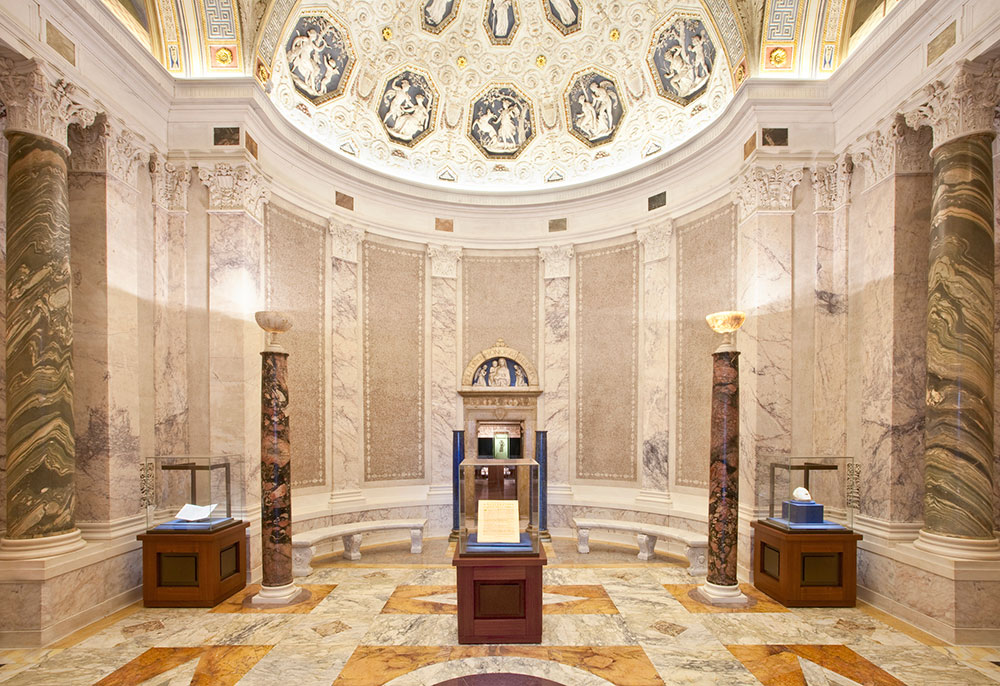Stop 13: The Rotunda

The Rotunda served as the entrance to the Library during Morgan’s lifetime. For the visitor who entered from the street, the austere monochromatic façade would suddenly yield to a soaring, well-lit space, sumptuous in its profusion of colored stones and jewel-toned paintings.
Vertical panels of mosaic tiles adorn the walls, alternating with marble pilasters. Free-standing marble columns are topped with alabaster bowls. And rich blue columns clad in tiles of lapis lazuli flank the small door, over which is mounted a blue-and-white glazed Renaissance relief. The central oculus illuminates the surrounding painted dome and the relief panels in the blue and white stuccoed apse, as well as three painted lunettes.
Stop 14: The Rotunda: Lunettes

Roger Wieck, Melvin R. Seiden Curator of Medieval and Renaissance Manuscripts
The space is distinguished by three lunettes, or semi-circular paintings, above the entrance and the doorways to Morgan’s library and study. The paintings were executed by Harry Siddons Mowbray and they celebrate the history of western European literature from three different eras.
Above the entrance to the library, the ancient world is represented by Orpheus and Homer and scenes from the Iliad and the Odyssey. The lunette above the front doors is dedicated to the medieval world, symbolized by chivalric romances, with depictions of King Arthur, Lancelot, and Guinevere, as well as Dante with his beloved Beatrice and guide Virgil. Above the entrance to Morgan’s study, the scene pays homage to the Renaissance, featuring the muse of lyric and amorous poetry and characters from the Italian poet Torquato Tasso’s Jerusalem Delivered, as well as Petrarch, whose sonnets honored his platonic love for Laura.
Mowbray painted these canvases in his studio and brought them to the library for installation. If you look closely, you will see that the gilded details are actually three-dimensional: Mowbray used a composite material to build these up so they would catch the light from the oculus. This was a technique used by the Renaissance painter Bernardino Pinturicchio, on whose sixteenth-century murals Mowbray’s were based. Mowbray also added a fictive, or trompe l'oeil, arch framing the painting above the entrance to match the real arches framing the other two lunettes.
Stop 15. The Rotunda: Dome and Apse

John Marciari, Charles W. Engelhard Curator of Drawings and Prints
The Rotunda is capped by a domed ceiling with a central oculus. The dome is adorned with paintings, some simulating marble reliefs or mosaics. This decoration was undertaken by Harry Siddons Mowbray, who also painted the lunettes in the Rotunda and the East Room. Around the central skylight are female personifications of Religion, Art, Science, and Philosophy. The overall layout of the dome is based on the ceiling in the Stanza della Segnatura of the Vatican Palace, painted by Raphael during the Italian Renaissance. The architect Charles Follen McKim studied that ceiling and adjusted a few details, such as the format of the paintings simulating reliefs, to work with the proportions of his dome. Mowbray also studied the same ceiling, and his paintings in the Morgan dome emulate the mellowed tones that characterized Raphael’s frescoes before their recent restoration.
In the semicircular apse, opposite the original entrance, are two rows of white stucco reliefs against a blue background. The vertical panels depict allegorical figures while the octagonal ones are devoted to Roman deities. Although Mowbray made the ceiling paintings in his studio and later mounted them in this space, these reliefs were modeled on site, so that Mowbray could study the way they interacted with the ambient light.
See Raphael ceiling in the Stanza della Segnatura, Vatican
Stop 16. Virgin and Child with Two Kneeling Angels in a Lunette

Attributed to Luca della Robbia (Italian, ca. 1400-1482)
Ca. 1460
Glazed terracotta
54 x 40 1/4 inches (1372 x 1022 mm.)
Purchased by Pierpont Morgan, 1910.
John Marciari, Charles W. Engelhard Curator of Drawings and Prints
Morgan’s Library was filled with Renaissance flourishes. For example, above the small doorway that led to the Librarian’s Office is a glazed terracotta relief by the Renaissance sculptor Luca della Robbia. It features the Madonna and child in the center, with an adoring angel kneeling on either side. The figures are framed by a stone surround inscribed with the Latin phrase Soli Deo Honor et Gloria, which means “Glory and honor to God alone.” While the lunette seems perfectly suited to the doorway, Morgan only acquired it in 1910, several years after the building was completed. It was tailored to fit the available space.
As is typical of Luca della Robbia’s work, the figures appear in white against a deep blue background. Della Robbia developed a new type of glaze in the 15th century that made his ceramics especially durable, while allowing for a rich diversity of colors. This elegant relief originally graced the entrance to the Renaissance oratory of Santa Maria della Quercia in Florence and was sold by a descendant of the original patron to Morgan through the dealer Elia Volpi. Additional colorful, glazed reliefs by the Della Robbia workshop and their contemporaries can be found on the walls outside Morgan’s study.